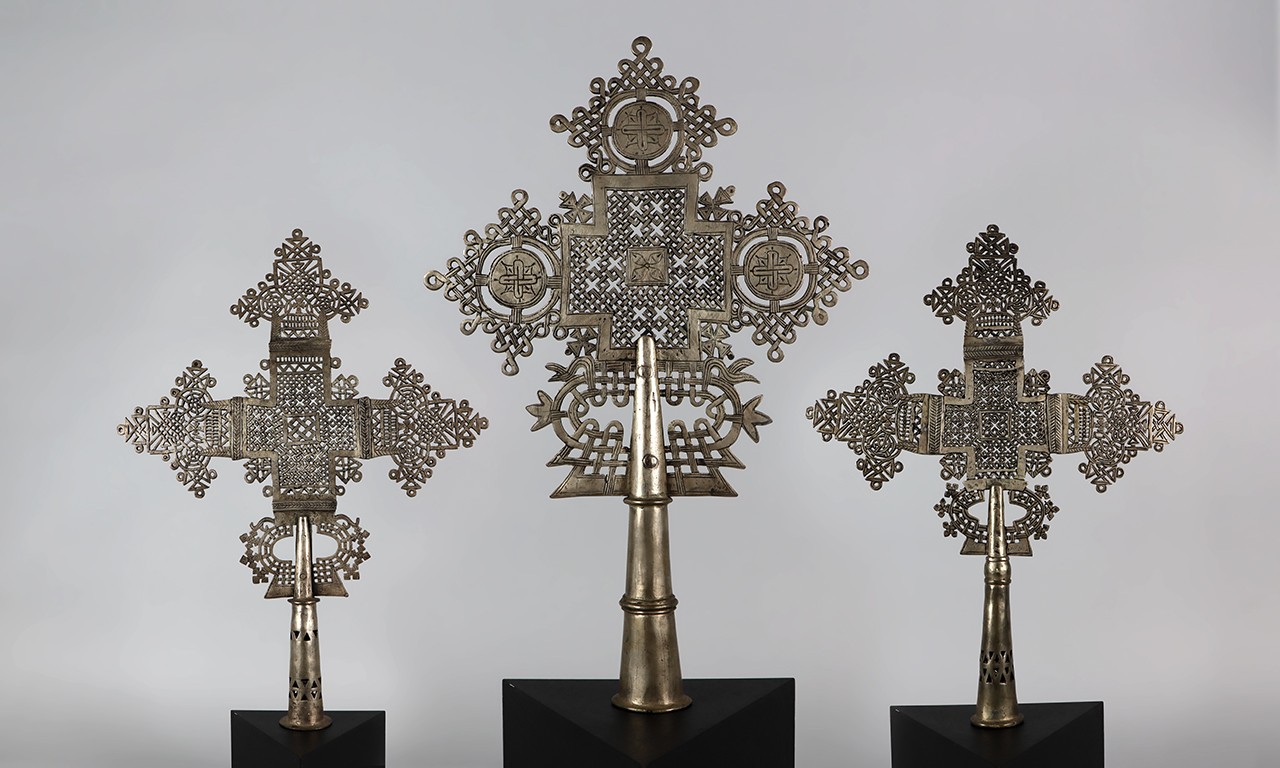 |
Processional Crosses, 20th Century
Ethiopia
Silver alloy; Various dimensions
2022.4.3-.5
Gift of The David Poiry Trust |
Dancing to the Beat of Their Own Drum
Christianity in Ethiopia is a product of almost two millennia of practice, isolation, and conflict. For much of the country’s history it has been isolated from other Christian countries, which has led to the development of unique religious architecture and practices not seen anywhere else. In this post, we explore a similarly inimitable object tradition through the context of a new acquisition: Ethiopian processional crosses.
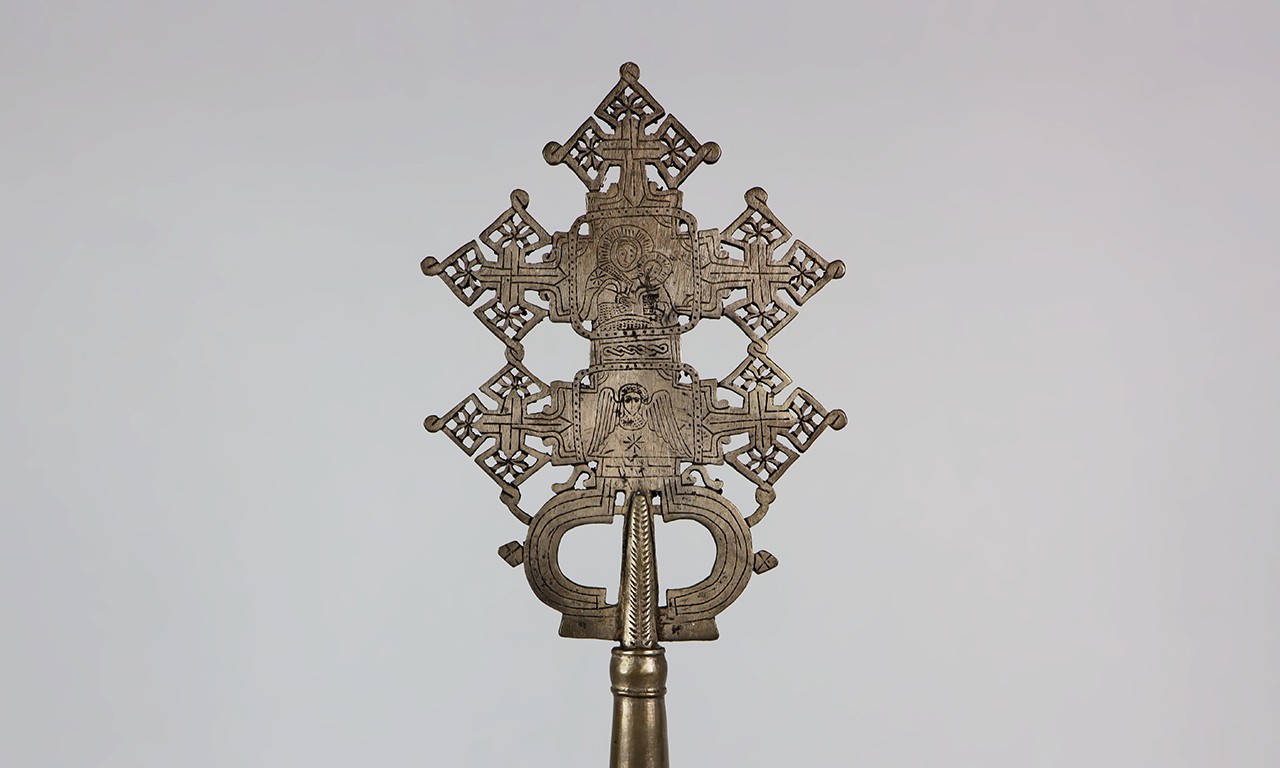 |
Processional Cross, 20th Century
Ethiopia
Silver alloy; 13 1/2 × 6 1/4 × 1 3/4 in.
2022.4.7
Gift of The David Poiry Trust |
Reconciled Faith
Around 340 CE, Ethiopia became one of the first Christian states in the world when the religion was spread from Egypt to its north. Aksum, the seat of the newly converted King Ezana and already the capital of the region, became the center of Christianity in Ethiopia. It was there that the Church of Our Lady Mary of Zion was built—though it has been destroyed and rebuilt at least twice since its 4th century inception. A growing debate regarding the aspects of God and man in Christ led to a meeting of holy men in the Byzantine Empire in 451. The result of the meeting, to adhere to the interpretation of the papacy, created a major schism with Churches throughout the Middle East, North Africa, and Asia that held that Christ was the embodied union of God and man. The Ethiopian Church’s name to this day is Tewahedo, which comes from the verb to ‘unite.’
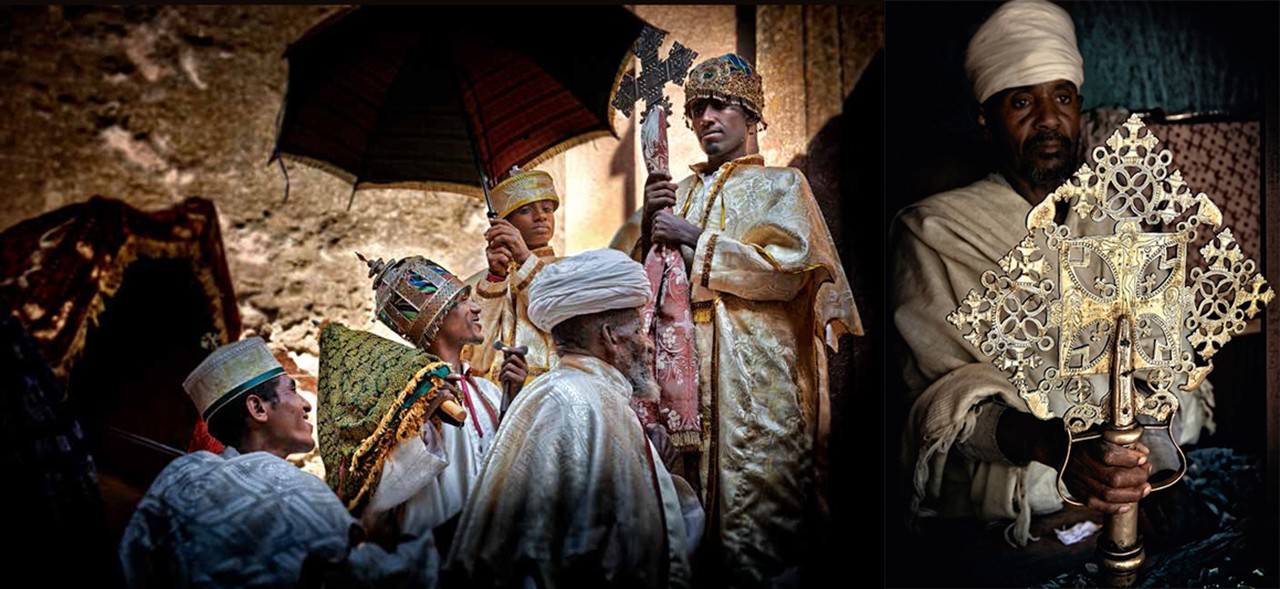 |
| Similar processional crosses being used by priests in Ethiopia |
Abyssinian Non-Assimilation
Though internal factions often vied for control, Ethiopian Christianity also foiled many external threats. The earliest of these, and perhaps the greatest, came in the 7th century when Islam spread through the Middle East and into Africa. It is not clear why Muslims did not invade Ethiopia. The likeliest theories are that the Prophet Mohammed had sent his family there to avoid persecution and was both grateful to the people of Ethiopia and impressed by their particular sect of Christianity; the other is that the mountainous terrain of the north provided a great advantage to defenders. Whatever the case, Ethiopia was allowed to continue its practice, now in newfound seclusion from its old allies in Egypt and around the Mediterranean. After a thousand years of internal conflicts, Ethiopia was again unified by a threat from abroad, this time in the form of the Catholic Portuguese who worked to modernize the country and bring Tewahedo back into the fold of the papacy. Despite swaying the king, the Ethiopian Church and public revolted, ousting the Portuguese. European powers returned toward the end of the 19th century, first with a successful invasion by British forces in 1868 and then with a far less successful attempt by Italy in 1896. Italian forces did return just before the onset of World War II and held the country for four years, killing a great many monks but not affecting the doctrine of the Ethiopian Church. Today Orthodox Christianity remains the country's plurality religion at around 44% of Ethiopia’s population.
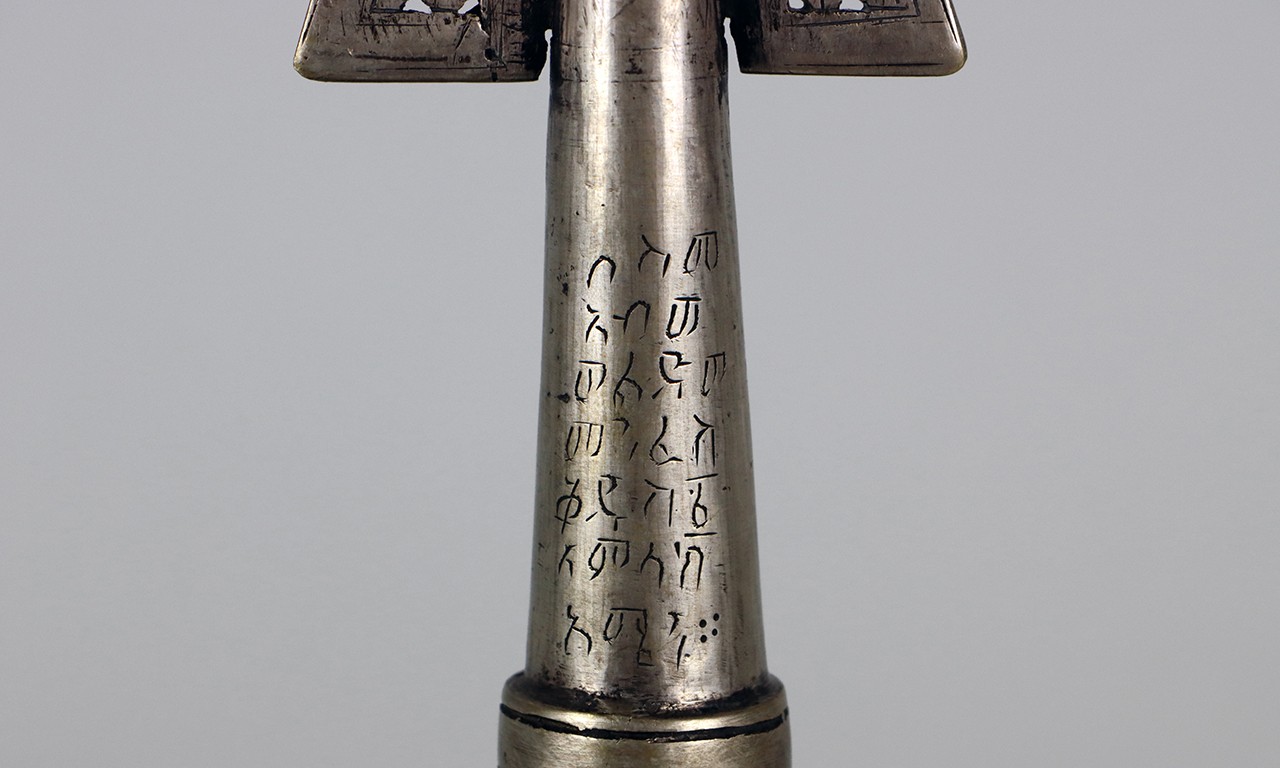 |
Detail of Processional Cross, 20th Century
Ethiopia
Silver alloy; 13 5/8 × 8 1/4 × 1 5/8 in.
2022.4.6
Gift of The David Poiry Trust |
Getting The Point, A Cross
The processional crosses featured in this post are very much a product of Ethiopia’s history. Despite Egypt being overwhelmingly Muslim, the Coptic Orthodox Church of Alexandria administrated the Ethiopian Orthodox Church up until 1959. It has been suggested that the use of the cross was popularized even before the advent of Christianity as an astronomical symbol and, in Egypt, as a variant of the ankh, a symbol of life which perfectly complemented Christ’s own life after death after the Christian cross was popularized by Constantine in the 4th century.
Three types of crosses are made in Ethiopia: those worn around the neck, those intended to be held, and these processional crosses, which had wooden staffs socketed into them. Of the three, processional crosses are by far the largest and tend to be reserved for various religious festivals such as Enkutatash (New Year). They are used exclusively by priests to bless individuals, to mark the rhythms of religious songs, for support during services that last upward of eight consecutive hours, and in other assorted ecclesiastical functions. The large loops at the bottom are used to tie swaths of fabric to the crosses.
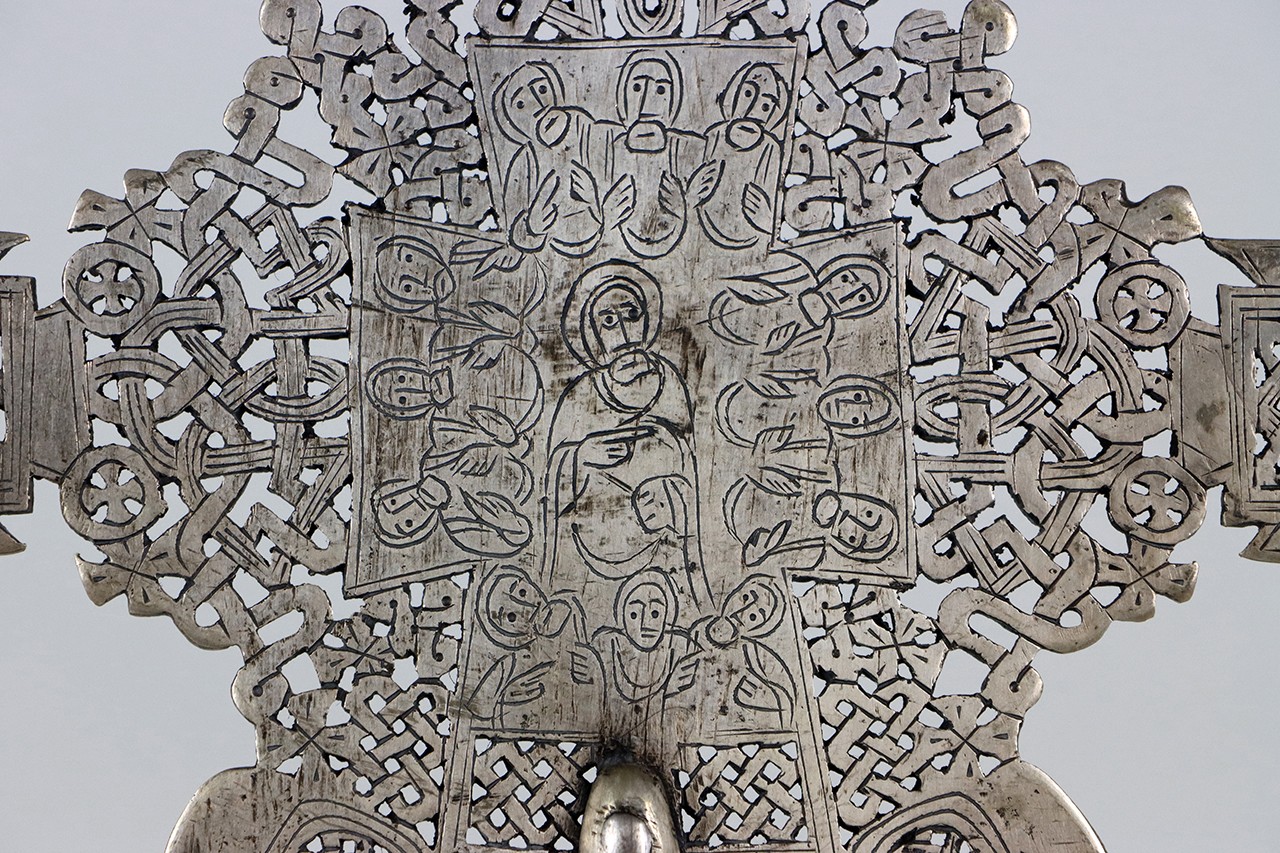 |
Detail of 2022.4.6
Gift of The David Poiry Trust |
Breaking the Mold
The oldest dated examples of Ethiopian processional crosses date to the 12th century, but production in the ancient centers of Aksum, Lalibela, and Gondar has never ceased since. These crosses in particular are stylistically almost identical to those made in the 16th century, right down to the Amharic or Ge’ez characters on the exterior of the socket. Based on the design, condition, their silver plating, that they are made of multiple pieces that are bolted and soldered together, and the inclusion of pictorial decoration rather than purely geometric and floral patterning—the latter point evidenced by Christ and his twelve apostles on the above detail—the Bowers processional crosses were likely made sometime in the 20th century.
Crosses are still made today, as they were historically, through lost wax casting. A model of a cross would be made from wax, a negative mold was made around it from clay, and then superheated metal was poured in. Molds are shattered to get out the metal, so no two crosses are exactly alike.
Text and images may be under copyright. Please contact Collection Department for permission to use. References are available on request. Information subject to change upon further research.






Comments